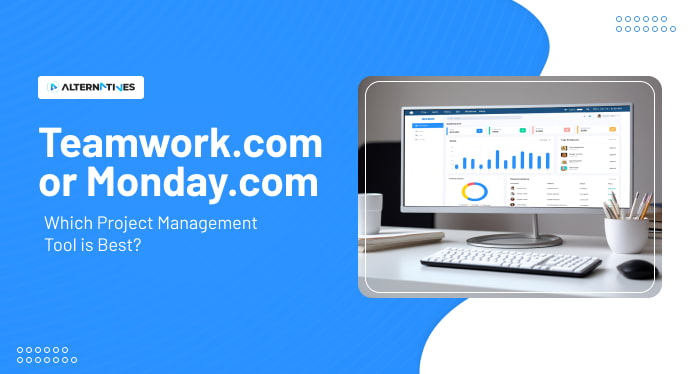Looker Vs. Tableau: Which BI Tool Reigns Supreme?

Business intelligence tools have become essential for modern organizations to stay competitive, yet with the growing number of options, which one best suits your purposes? Looker and Tableau are two popular data analytics platforms that offer comprehensive solutions for data analysis. But which one is the best choice for you? In this article, we will compare Looker and Tableau in terms of their data sources, data visualization capabilities, ease of use, reporting capabilities, integrations, and more to help you make an informed decision.
A Quick Overview of Looker
Looker is a powerful business intelligence (BI) tool designed for data exploration and analysis. Its user-friendly interface facilitates intuitive navigation, allowing users to effortlessly uncover meaningful insights. Looker’s notable features include real-time collaboration, customizable dashboards, and robust data modelling. Explore our curated top list of tools similar to Looker by clicking here for users seeking comparable solutions.
A Quick Overview of Tableau
Tableau is a leading business intelligence platform, renowned for its intuitive data visualization and analytics capabilities. With features like interactive dashboards, drag-and-drop functionality, and diverse connectivity options, Tableau simplifies complex data exploration. There are several Tableau alternatives available that offer similar or even better functionality that users can check out.
Features Comparison For Looker Vs Tableau
| Feature | Looker | Tableau |
| Data Exploration | Enables intuitive exploration of complex datasets with a user-friendly interface. | Provides a robust environment for visualizing and analyzing data effortlessly. |
| Interactive Dashboards | Allows users to create interactive and customizable dashboards for dynamic data representation. | Offers a versatile dashboard creation tool with a wide range of interactive elements. |
| Drag-and-Drop Functionality | Facilitates easy manipulation of data through a drag-and-drop interface, enhancing user experience. | Simplifies data analysis through intuitive drag-and-drop actions, promoting efficiency. |
| Data Modeling | Supports advanced data modelling for creating complex relationships and hierarchies within the data. | Provides robust data modelling capabilities to structure and analyze data effectively. |
| Real-Time Collaboration | Fosters collaboration by allowing real-time sharing and editing of reports and dashboards. | Promotes team collaboration through real-time sharing and collaborative editing features. |
| Customizable Reports | Enables users to create customized reports tailored to specific business requirements. | Offers a high degree of report customization for presenting data in a format that suits individual needs. |
| Scalability | Scales effectively to handle growing datasets and increasing user demands. | Designed for scalability, ensuring optimal performance as data volumes and user numbers expand. |
| Connectivity Options | Provides diverse connectivity options to integrate seamlessly with various data sources. | Supports multiple data source connections, offering flexibility in integrating with different databases and applications. |
| Embedding Capabilities | Allows embedding of dashboards and reports into external applications for wider accessibility. | Supports embedding, enabling the integration of Tableau visualizations into other platforms. |
| Mobile Accessibility | Offers mobile-friendly features for accessing and interacting with data on the go. | Provides a mobile app for accessing and interacting with Tableau visualizations from smartphones and tablets. |
| Ad-Hoc Analysis | Facilitates ad-hoc analysis by allowing users to explore and analyze data on the fly. | Supports ad-hoc analysis, empowering users to analyze data dynamically as per evolving business needs. |
| Security | Implements robust security measures to protect sensitive data and ensure compliance. | Prioritizes data security with comprehensive features to control access and safeguard information. |
| Version Control | Provides version control features for managing changes to data models and reports. | Incorporates version control mechanisms to track and manage changes made to dashboards and datasets. |
| Pricing | Looker offers three platform editions: Standard, Enterprise, and Embed. Platform pricing is $5,000/month for Standard. Viewer user license costs $30/user/month | Tableau’s pricing varies for Creator, Explorer, and Viewer plans. For detailed pricing, contact Tableau’s sales team to get a customized quote based on your specific business needs. |
| Training Resources | Offers a wealth of training resources, documentation, and support for users to master the platform. | Provides extensive training materials, documentation, and a supportive community for users to enhance their Tableau skills. |
Looker Vs Tableau: Features Comparison
1. Data Exploration
Data Exploration is a pivotal feature in both Looker and Tableau, offering intuitive tools for uncovering insights. Looker’s Data Exploration excels in user-friendly navigation, facilitating effortless exploration of complex datasets. Conversely, Tableau provides a robust environment for dynamic data visualization and analysis. While Looker emphasizes simplicity in exploration, Tableau’s strength lies in its diverse visualization options, offering users a broader spectrum for uncovering patterns and trends within their data and enhancing the overall data discovery experience.
2. Interactive Dashboards
Interactive Dashboards are a hallmark of Looker and Tableau, elevating data presentation and analysis. Looker’s dashboards offer user-friendly customization, allowing seamless creation of interactive displays. In contrast, Tableau boasts a versatile dashboard tool with a plethora of interactive elements, promoting dynamic data exploration. Looker’s emphasis is on simplicity and ease of use, while Tableau provides a rich array of features, enabling users to build highly interactive and visually compelling dashboards that cater to diverse business needs.
3. Drag and Drop Functionality
The Drag-and-Drop Functionality is a key asset in Looker and Tableau, simplifying data manipulation for users. Looker’s interface allows effortless dragging and dropping, enhancing user experience in data analysis. Meanwhile, Tableau’s drag-and-drop functionality is integral to its intuitive design, providing users with a seamless experience in organizing and exploring data. Both platforms prioritize simplicity and efficiency, offering users the ability to interact with and transform data through intuitive drag-and-drop actions effortlessly.
4. Data Modelling
Data Modeling is a core capability in Looker and Tableau, shaping the foundation for insightful analysis. Looker excels in advanced data modelling, allowing users to create intricate relationships and hierarchies within their datasets. On the other hand, Tableau offers robust data modelling features, providing users with the tools to structure and analyze data effectively. Looker focuses on empowering users with advanced modelling options, while Tableau ensures a solid framework for organizing and deriving insights from complex datasets.
5. Real-time Collaboration
Real-time collaboration is a standout feature in both Looker and Tableau, enhancing teamwork in data analysis. Looker enables seamless collaboration through real-time sharing and editing of reports and dashboards, fostering collective decision-making. Similarly, Tableau promotes team collaboration by facilitating real-time sharing and collaborative editing. While Looker emphasizes intuitive collaboration within its user-friendly interface, Tableau’s strength lies in providing users with shared, real-time access to visualizations, ensuring that insights are developed collaboratively and decisions are made collectively.
6. Customizable Reports
Customizable Reports are a cornerstone in Looker and Tableau, tailoring insights to meet specific business needs. Looker empowers users with the ability to create bespoke reports, ensuring flexibility in presenting data. Tableau, similarly, offers a high degree of report customization, allowing users to adapt visualizations to suit individual preferences. While Looker focuses on user-friendly customization, Tableau provides a robust set of tools for creating tailored reports, ensuring that organizations can effectively communicate insights in a format that aligns with their unique requirements.
7. Scalability
Scalability is a pivotal strength shared by Looker and Tableau, ensuring optimal performance as data volumes and user demands expand. Looker seamlessly scales to handle growing datasets and increasing user loads, providing a robust solution for evolving business needs. Likewise, Tableau is designed for scalability, offering a platform that grows in tandem with organizational requirements, ensuring that both Looker and Tableau remain versatile and effective tools as businesses encounter larger datasets and increased demand for analytical capabilities.
8. Connectivity Options
Connectivity Options are a vital component in Looker and Tableau, facilitating seamless integration with diverse data sources. Looker provides users with a range of connectivity options, ensuring compatibility with various data platforms. Similarly, Tableau supports multiple data source connections, offering users flexibility in integrating with different databases and applications. Whether connecting to cloud services or on-premises databases, both Looker and Tableau prioritize comprehensive connectivity options, allowing users to access and analyze data from various sources effortlessly.
9. Embedding Capabilities
Embedding is a pivotal feature in Looker and Tableau, enhancing accessibility and integration. Looker allows users to embed dashboards and reports into external applications, expanding the reach of data insights. Similarly, Tableau supports embedding, seamlessly integrating visualizations into other platforms for wider accessibility. While Looker emphasizes user-friendly embedding options, Tableau provides a versatile solution, ensuring that organizations can effortlessly integrate analytics into their existing applications, websites, or portals, facilitating a seamless and cohesive user experience.
10. Mobile Accessibility
Mobile Accessibility is a shared strength in Looker and Tableau, ensuring users can access and interact with data on the go. Looker offers mobile-friendly features, providing a responsive interface for users on various devices. Similarly, Tableau provides a dedicated mobile app, enabling users to access and interact with visualizations seamlessly from smartphones and tablets. Whether through responsive design or a dedicated app, both Looker and Tableau prioritize mobile accessibility, empowering users to stay connected with their data anytime, anywhere.
11. Ad-Hoc Analysis
Ad-hoc Analysis is a pivotal capability in Looker and Tableau, allowing users to dynamically explore and analyze data. Looker facilitates ad-hoc analysis with an intuitive interface, empowering users to uncover insights on the fly. Similarly, Tableau supports ad-hoc analysis, providing users with tools for dynamic exploration of data as business needs evolve. Both Looker and Tableau prioritize flexibility, allowing users to conduct spontaneous and exploratory analyses, and ensuring that data-driven decisions can be made promptly in response to evolving business questions.
12. Security
Security is paramount in Looker and Tableau, safeguarding sensitive data and ensuring compliance. Looker implements robust security measures, controlling access to data and providing comprehensive audit trails. Similarly, Tableau prioritizes data security, offering features to restrict access and protect information. Both platforms provide organizations with the tools to enforce security policies, ensuring that data integrity is maintained, and regulatory requirements are met. Looker and Tableau’s commitment to security underscores their reliability in handling confidential business information.
13. Version Control
Version Control is a critical aspect of both Looker and Tableau, facilitating effective management of changes to data models and reports. Looker provides version control features, enabling users to track and manage alterations to dashboards and datasets systematically. Likewise, Tableau incorporates version control mechanisms, allowing users to monitor changes made to visualizations and reports. Both platforms prioritize version control, ensuring that users can maintain a clear record of modifications, collaborate seamlessly, and safeguard the integrity of their analytical workflows.
14. Pricing
With regards to Looker pricing, it provides three subscription plans: Standard at $5,000/month, Enterprise, and Embed. Viewer user licenses for Looker cost $30/per user/month. Coming to Tableau's pricing it offers three plans: Creator, Explorer, and Viewer, with detailed pricing available through their sales team. For tailored business intelligence solutions, organizations can choose between Looker and Tableau, each offering distinct features and pricing models to meet diverse analytical needs. It’s recommended to reach out to the respective sales teams for detailed quotes based on specific requirements.
15. Training Resources
Training Resources are crucial for mastering Looker and Tableau, ensuring users can harness the full potential of these BI tools. Looker offers a wealth of training materials and documentation, supported by a robust online community. Similarly, Tableau provides extensive training resources, including tutorials, forums, and user groups, fostering a supportive learning environment. While Looker focuses on user-friendly guides and community engagement, Tableau’s comprehensive training ecosystem caters to diverse learning preferences, enabling users to enhance their analytical skills effectively.
Looker Vs Tableau – Which is Better?
The choice between Looker and Tableau depends on specific business requirements and preferences. Looker excels in data modelling, offering advanced capabilities for creating intricate relationships within datasets. Its user-friendly interface prioritizes simplicity in exploration. For an informed decision-making process, consider checking out reviews for Looker.
Why Looker is better:
- Intuitive Exploration: Looker excels in user-friendly data exploration.
- Real-Time Collaboration: Robust real-time collaboration features enhance teamwork.
- Customizable Interface: Looker provides a customizable interface for tailored user experiences.
- Simplicity: Looker emphasizes simplicity in data analysis.
- Navigation: Strong support for easy and intuitive navigation.
Why Tableau is better:
Tableau stands out for its versatile dashboard creation tools and extensive visualization options. Let's understand more precisely as to why Looker is better than Tableau and Vice Versa. Explore Tableau's reviews to make well-informed decisions based on user experiences.
- Diverse Visualizations: Tableau offers a wide range of diverse visualization options.
- Data Modeling: Robust data modelling capabilities enhance structuring and analysis.
- Community Support: Tableau has an extensive and supportive user community.
- Versatile Dashboards: Tableau excels in creating versatile and interactive dashboards.
- Connectivity Options: Comprehensive connectivity options for diverse data sources.
- Geospatial Analysis: Powerful features for geospatial analysis.
Frequently Asked Questions
What is Looker?
Looker is a business intelligence and data exploration platform. It empowers users to analyze and visualize complex datasets through an intuitive interface. With features like real-time collaboration and customizable dashboards, Looker facilitates data-driven decision-making for organizations across various industries.
What is Tableau?
Tableau is a visual analytics platform that helps people and organizations explore, manage, and share data insights with intuitive, visual tools. It is used by businesses of all sizes to quickly and easily analyze data.
What are the differences between Looker and Tableau?
Looker and Tableau have a lot in common, but they also have some key differences that might impact which one you choose. Looker is best suited for larger organizations with a developed data team capable of designing and managing dashboards with LookML. Tableau is best suited for smaller organizations with smaller data teams but several employees who must use data visualizations to gain insights.
What are the features of Looker and Tableau?
Looker's features include data visualization, data analysis, data modelling, version control, simultaneous collaboration, LookML, Looker Blocks and marketplace. Tableau's features include data visualization, data analysis, data modelling, and a drag-and-drop interface for ease of use.
What is the best use case for Looker and Tableau?
Looker is best suited for larger organizations with a developed data team capable of designing and managing dashboards with LookML. Tableau is best suited for smaller organizations with smaller data teams but several employees who must use data visualizations to gain insights.
What are the integration options for Looker and Tableau?
Looker is part of the Google Cloud Platform (GCP) and can easily integrate into most pre-existing business intelligence (BI) workflows. Tableau has native integration with Salesforce CRM and Slack, and can easily integrate into most pre-existing BI workflows.
Conclusion
In conclusion, Looker and Tableau are both formidable business intelligence tools, each with distinct strengths. Looker stands out for its user-friendly exploration and real-time collaboration, while Tableau excels in diverse visualizations, robust data modelling, and extensive community support. The choice between them hinges on specific business needs, user preferences, and the analytical requirements of organizations seeking actionable insights and data-driven decision-making.



